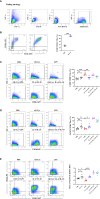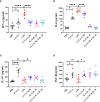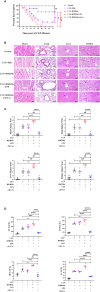Schistosoma japonicum Cystatin Alleviates Sepsis Through Activating Regulatory Macrophages
- PMID: 33718268
- PMCID: PMC7943722
- DOI: 10.3389/fcimb.2021.617461
Schistosoma japonicum Cystatin Alleviates Sepsis Through Activating Regulatory Macrophages
Abstract
Multi-organ failure caused by the inflammatory cytokine storm induced by severe infection is the major cause of death for sepsis. Sj-Cys is a cysteine protease inhibitor secreted by Schistosoma japonicum with strong immunomodulatory functions on host immune system. Our previous studies have shown that treatment with Sj-Cys recombinant protein (rSj-Cys) attenuated inflammation caused by sepsis. However, the immunological mechanism underlying the immunomodulation of Sj-Cys for regulating inflammatory diseases is not yet known. In this study, we investigated the effect of Sj-Cys on the macrophage M2 polarization and subsequent therapeutic effect on sepsis. The rSj-Cys was expressed in yeast Pichia pastoris. Incubation of mouse bone marrow-derived macrophages (BMDMs) with yeast-expressed rSj-Cys significantly activated the polarization of macrophages to M2 subtype characterized by the expression of F4/80+ CD206+ with the elated secretion of IL-10 and TGF-β. Adoptive transfer of rSj-Cys treated BMDMs to mice with sepsis induced by cecal ligation and puncture (CLP) significantly improved their survival rates and the systemic clinical manifestations of sepsis compared with mice receiving non-treated normal BMDMs. The therapeutic effect of Sj-Cys-induced M2 macrophages on sepsis was also reflected by the reduced pathological damages in organs of heart, lung, liver and kidney and reduced serological levels of tissue damage-related ALT, AST, BUN and Cr, associated with downregulated pro-inflammatory cytokines (IFN-gamma and IL-6) and upregulated regulatory anti-inflammatory cytokines (IL-10 and TGF-β). Our results demonstrated that Sj-Cys is a strong immunomodulatory protein with anti-inflammatory features through activating M2 macrophage polarization. The findings of this study suggested that Sj-Cys itself or Sj-Cys-induced M2 macrophages could be used as therapeutic agents in the treatment of sepsis or other inflammatory diseases.
Keywords: Schistosoma japonicum; adoptive transfer; cysteine protease inhibitor; immunomodulation; macrophage; sepsis.
Copyright © 2021 Xie, Wu, Chen, Gao, Li, Yuan, Liang, Wang, Wang, Xu, Chu, Zhan, Zhou and Yang.
Conflict of interest statement
The authors declare that the research was conducted in the absence of any commercial or financial relationships that could be construed as a potential conflict of interest.
Figures





Similar articles
-
Therapeutic effect of Schistosoma japonicum cystatin on bacterial sepsis in mice.Parasit Vectors. 2017 May 8;10(1):222. doi: 10.1186/s13071-017-2162-0. Parasit Vectors. 2017. PMID: 28482922 Free PMC article.
-
Schistosoma japonicum cystatin alleviates paraquat poisoning caused acute lung injury in mice through activating regulatory macrophages.Ecotoxicol Environ Saf. 2024 Aug;281:116615. doi: 10.1016/j.ecoenv.2024.116615. Epub 2024 Jun 20. Ecotoxicol Environ Saf. 2024. PMID: 38905933
-
Therapeutic efficacy of Schistosoma japonicum cystatin on sepsis-induced cardiomyopathy in a mouse model.Parasit Vectors. 2020 May 18;13(1):260. doi: 10.1186/s13071-020-04104-3. Parasit Vectors. 2020. PMID: 32423469 Free PMC article.
-
[Role of Mitophagy Affecting Macrophage Polarization in Immunomodulationin Sepsis and Traditional Chinese Medicine Intervention:A Review].Zhongguo Yi Xue Ke Xue Yuan Xue Bao. 2024 Oct;46(5):720-731. doi: 10.3881/j.issn.1000-503X.15849. Zhongguo Yi Xue Ke Xue Yuan Xue Bao. 2024. PMID: 39502054 Review. Chinese.
-
Parasite Cystatin: Immunomodulatory Molecule with Therapeutic Activity against Immune Mediated Disorders.Pathogens. 2020 May 30;9(6):431. doi: 10.3390/pathogens9060431. Pathogens. 2020. PMID: 32486220 Free PMC article. Review.
Cited by
-
Helminth-derived molecules: Pathogenic and pharmacopeial roles.J Biomed Res. 2024 Sep 24;38(6):547-568. doi: 10.7555/JBR.38.20240177. J Biomed Res. 2024. PMID: 39314046 Free PMC article.
-
The role of lung macrophages in acute respiratory distress syndrome.Inflamm Res. 2022 Dec;71(12):1417-1432. doi: 10.1007/s00011-022-01645-4. Epub 2022 Oct 20. Inflamm Res. 2022. PMID: 36264361 Free PMC article. Review.
-
The Fight Against Severe COVID-19: Can Parasitic Worms Contribute?Front Immunol. 2022 Feb 11;13:849465. doi: 10.3389/fimmu.2022.849465. eCollection 2022. Front Immunol. 2022. PMID: 35222441 Free PMC article. No abstract available.
-
Therapeutic Effect of Schistosoma japonicum Cystatin on Atherosclerotic Renal Damage.Front Cell Dev Biol. 2021 Nov 25;9:760980. doi: 10.3389/fcell.2021.760980. eCollection 2021. Front Cell Dev Biol. 2021. PMID: 34901005 Free PMC article.
-
Amblyostatin-1, the first salivary cystatin with host immunomodulatory and anti-inflammatory properties from the Neotropical tick Amblyomma sculptum, vector of Brazilian spotted fever.Front Immunol. 2025 Jul 17;16:1585703. doi: 10.3389/fimmu.2025.1585703. eCollection 2025. Front Immunol. 2025. PMID: 40746554 Free PMC article.
References
-
- Baghdadi J. D., Brook R. H., Uslan D. Z., Needleman J., Bell D. S., Cunningham W. E., et al. . (2020). Association of a care bundle for early sepsis management with mortality among patients with hospital-onset or community-onset sepsis. JAMA Intern. Med. 180, 707–716. 10.1001/jamainternmed.2020.0183 - DOI - PMC - PubMed
-
- Bisht N., Khatri V., Chauhan N., Kalyanasundaram R. (2019). Cystatin from filarial parasites suppress the clinical symptoms and pathology of experimentally induced colitis in mice by inducing T-Regulatory cells, B1-cells, and alternatively activated macrophages. Biomedicines 31, 7(4)–7(85. 10.3390/biomedicines7040085 - DOI - PMC - PubMed
Publication types
MeSH terms
Substances
Supplementary concepts
LinkOut - more resources
Full Text Sources
Other Literature Sources
Medical
Miscellaneous

